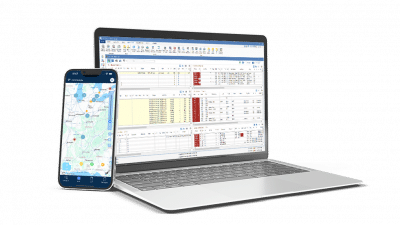Check the tires, brakes, and lights, and top off fluids. Seems easy enough — you don’t need a truck maintenance checklist to remember those points. But the federal regulations for truck maintenance and operation are lengthy and detailed, and without a checklist, you might miss an essential compliance requirement.
Ready to test your knowledge of truck maintenance requirements? Take our 16-question quiz (answers are at the end), then read about what to include in a semi truck maintenance checklist.
Quiz Part 1: True or False
- A damaged/ineffective windshield wiper is an automatic fail for annual inspections.
- Driver Vehicle Inspection Reports (DVIR) are due at the end of every trip.
- If a roadside inspector issues your truck an out of service violation due to unsafe operation, the driver can’t operate the truck.
- You only have to check axle alignment annually.
- A tire with exposed ply or cord is acceptable during an annual inspection if it holds pressure.
- Reflectors or conspicuity treatments are required on trailers, but not on tractors.
- Drivers are not required to carry a copy of their vehicle’s periodic inspection report.
- A crack in the windshield will result in a failed annual inspection.
Quiz Part 2: Multiple Choice
- How long do you have to keep periodic inspection reports?
- 6 months
- 12 months
- 14 months
- For wedge brakes, movement on the scribe mark on the lining cannot exceed:
- 1/8 inch
- 1/4 inch
- 1/16 inch
- DOT number decals on a truck must be visible from ___ away.
- 50 feet
- 30 feet
- 20 feet
- What is the minimum tread depth for tires on the front wheels of a CMV?
- 1/32 inch
- 4/32 inch
- 3/32 inch
- For a CMV, a fire extinguisher is required to have a minimum rating of:
- 4 B:C
- 5 B:C
- 10 B:C
- 20 B:C
- How long must drivers retain their roadside inspection reports?
- 6 months
- 12 months
- 3 months
- What’s the acceptable flash interval for blinking turn signals?
- 60-120 flashes per minute
- 40-60 flashes per minute
- There is no federal rule about flash intervals
- At what PSI should the low air warning system activate in an air brake system?
- 80 PSI
- 70 PSI
- 55 PSI
- 55 PSI, or one-half of the compressor governor cutout pressure, whichever is less
Truck Maintenance Requirements Checklist
If you got a perfect score on the quiz, congratulations! If you didn’t get a perfect score, here are some tips for daily, weekly, monthly, quarterly, and annual maintenance:
Daily Pre-Trip and Post-Trip Inspection
Exterior
- Inspect lights (headlights, brake lights, turn signals) for functionality.
- Check for visible damage or leaks under the truck.
- Inspect tires for wear or damage and check the inflation.
- Clean mirrors and ensure they’re properly aligned.
- Make sure required decals and DOT number are fully secure and visible.
Engine Compartment
- Check engine oil.
- Check coolant levels and look for leaks.
- Inspect belts and hoses for cracks or wear.
Cabin
- Test the horn, wipers, and dashboard lights.
- Confirm proper function of brakes and parking brake.
- Clean windows and look for cracks or dings.
- Ensure ELD is functioning properly.
Cargo & Attachments
- Inspect cargo security and straps.
- Ensure trailer connections and electrical wiring are secure.
Weekly Maintenance
Engine
- Check and refill power steering fluid.
- Inspect and clean (or replace) the air filter.
- Check the battery terminals for corrosion and ensure they’re tightly connected.
Tires
- Rotate tires if wear is uneven.
- Confirm lug nuts are secure.
Brakes
- Test for unusual noises or reduced braking efficiency.
- Inspect brake pads and drums for wear.
Safety Equipment
- Ensure fire extinguishers and first-aid kits are in place and functional.
- Replenish emergency supplies if necessary.
Monthly Maintenance
Fluids
- Change engine oil if due.
- Check transmission, brake, and windshield washer fluid levels.
Chassis
- Lubricate chassis components per manufacturer recommendations.
- Inspect the suspension for wear or damage.
Electrical System
- Inspect wiring and connectors for signs of fraying or corrosion.
- Test battery charge levels.
Trailer Maintenance
- Check trailer alignment and trailer tires.
- Inspect for structural damage or rust.
Quarterly Maintenance
Inspection
- Perform a comprehensive inspection of the drivetrain.
- Check axle alignment and wheel bearings.
Cooling System
- Flush and replace coolant if necessary.
- Inspect radiator and hoses for damage.
Fuel System
- Replace fuel filters as required.
- Check the fuel injectors for efficiency.
Software and Electronics
- Update telematics and GPS systems.
- Perform diagnostics on Engine Control Units (ECUs).
Annual Maintenance
Regulatory Compliance
- Conduct DOT inspections (requires an authorized inspector)
- Verify safety and emissions compliance.
Major Systems:
- Inspect heating and cooling systems.
- Inspect and test the full brake system, including lines and reservoirs.
Records Review:
- Audit maintenance logs to identify recurring issues.
- Update preventative maintenance schedules as needed.
Quiz Answers
Part 1: True or False
- True
- False (Drivers need to submit reports at the end of every day)
- False (If leaving the truck where it is poses a greater safety risk than driving it to another location for repairs, the truck can be moved)
- False (You need to check axle alignment quarterly)
- False
- False (Tractors require reflectors)
- False
- False (Cracks are allowable if narrower than 1/4 inch and not intersected by another crack)
Part 2: Multiple Choice
- C
- C
- A
- B
- A or B (One extinguisher of 5 B:C or more, or two extinguishers of 4 B:C or more)
- A
- A
- D
Keep Trucks Rolling With PCS
Tracking and managing maintenance is a critical component of truck fleet management, and it’s also a time-consuming process. With PCS TMS for Carriers, you can automate maintenance monitoring and scheduling — no more spreadsheets required!
Find out how PCS TMS keeps trucks rolling, ensures compliance, and boosts profitability. Schedule your demo now.



